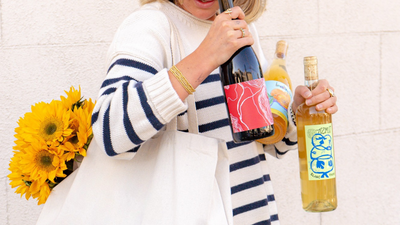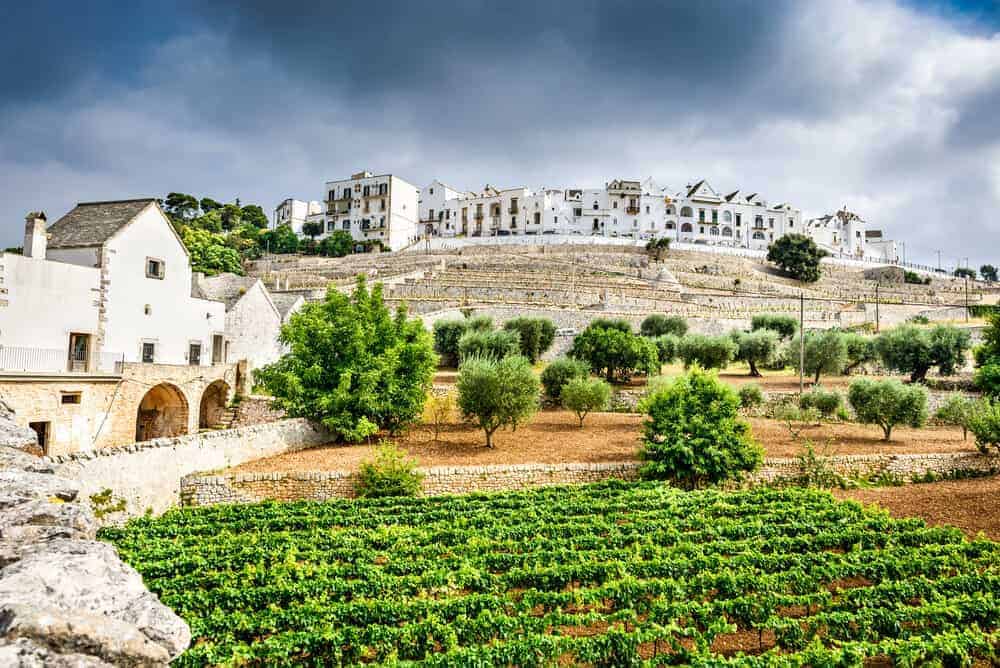Puglia, or Apulia, also known as the heel of the boot (il tacco dello stivale), as Italy’s shape reminds us of that, is a region that stretches from the Adriatic Sea on its eastern side, with the southern part of the heel wetted in the Ionian Sea.
Molise is its northern border neighbor, while Campania and Basilicata lie to the western side. There are 6 provinces: Foggia, Barletta-Andria-Trani, Brindisi, Taranto and Lecce, with Bari being the capital.
Geographically, Puglia is mostly a flat plain, known as Il Tavoliere delle Puglie. which is the second largest plain in Italy after the Pianura Padana in the Po Valley in Northern Italy. This type of configuration is perfectly suitable for agriculture, but it is the tourism that lately contributed to increase the region’s income, giving Puglia on of the higher GDP among the southern regions of the country.
Puglia is not a hidden secret anymore. Being the subject of much fanfare in travel sections, travel blogs or cooking shows, this region has become a busy tourist destination in recent years. From the green-forested Gargano’s promontory in the northen part if this region, with its small coves and beach carved in the rock, to Salento down to its the southern tip, there is something for every tourist to enjoy. Passing through the masserie, you'll find old farm estates that are now vacation rentals. The unique landscape of Alberobello has its trulli, ancient buildings used until few decades ago both as home and stable for sheep and other animals, and many of these are now converted into apartments for visitors. You can also pass the day walking though Lecce admiring the beautiful baroque buildings.
Those and more are reasons worth visiting Puglia. Unfortunately, our freedom to travel is been limited since the Covid-19 pandemic start to spread across the globe. We all hoping to get back to our lives before the virus, but until then, we have to use our imagination and our computer to see people and places. In our case, the wine will be our “media”. A bottle tells a story. It talks of places and people who live there and work the land, grow the vines and make the wine. The wine carries the color, perfume and taste of the place where is from.
Let’s fill the glass, close our eyes, and taste Puglia.
Buon viaggio.
Elio Longobardi, Italian Wine Specialist
PlumpJack Wine & Spirits – Noe Valley
Masseria Cuturi 1881 Segreto di Bianca Fiano Puglia IGT 2018 varieties.
About the Winery: A perfect example of how the economy of the region is transforming today is this estate. Founded in 1881 after a marriage between a wealthy landowner, Tommaso Schiavoni Tafuri and the Countess Bianca Sabini di Altamura, who brought some cut of Primitivo grapes as dowry. We are in the territory of Maduria, in Taranto province, the Primitivo’s cradle.
Masseria Cuturi is a unique 270 hectares property located in Manduria, composed of more than 30 hectares of planted Primitivo, Negramaro and Fiano grape, extending to 100 hectares completely dedicated to native Puglia varieties.
Part of the estate is dedicated to ancient olive trees, some of them about 500 years old. Those olive trees are the proud of the region but today are under siege but the deadly Xylella fastidiosa bacterium, know to us as Pierce’s disease.
This estate went through several owners. In 2015, Camilla Rossi-Chauvenet, an successful entrepreneur in the wine sector from Valpolicella, Veneto, bought it with the idea to give a prominent place to the wine but also to valorize the entire property opening to tourist that can rent rooms in the old farmhouse, visit the cellar and the many small towns around as the sandy beaches and clear water near by.
Masseria is the term used in south Italy to indicate the farmhouse itself but also the estate as whole.
About the Winemaking: The hot Mediterranean climate, persistent sunshine and occasional sea breezes make for a near-perfect environment for viticulture. Extraordinary soil composed of cretaceous limestone under layers of iron-rich quaternary deposits. Valentino Ciarla has the right elements to create wines that are the expression of this terroir. Sustainable and organic practices are Valentino tools in the vineyard and in the cellar.
Harvest time for Segreto di Bianca is end of August. Maceration, malolactic fermentation and aging period of three months all taking place in stainless steel vats.
Tasting Notes: Segreto di Bianca is obtain from Minutolo grape, also called Fiano Minutolo. It’s an indigenous grape of Puglia related to Moscato family and not to Fiano from Campania as wrongly the name suggest. Minutolo is aromatic variety. Another case of how Italian names of grape varietals can be confusing.
The color is a warm yellow gold. Yellow nectarine and ripe apricot, with remind of dry mango to the nose. Stone fruits but less prevalent at the tasting, with a more accentuate mineral salinity.
Tenute Rubino, Oltreme’, Susumaniello, Salento IGT 2016
About the Winery: In the late 1980s, Tommaso Rubino converted his grain and vegetable farms to vines for winemaking. He helped pioneer the region’s shift away from bulk production towards an emphasis on quality, while showcasing Puglia’s native grape varietals. With vineyards spanning along Puglia’s eastern coastline around the town of Brindisi, Tommaso Rubino, and his son Luigi have worked for decades to promote Puglia’s indigenous varietals.
It was Luigi enthusiasm that in 1999 starts bottling the wine that until then was sold in bulk.
Beside Primitivo, Negroamaro and Malvasia the real star of Torre Rubino is Susumaniello. They were one of the first producers to bottle 100% Susumaniello. A red varietal thought to be of Dalmatian origin, seems to be instead related to Garganega, Albana, Trebbiano Toscano among the others, all white varietals! This may explain why the wines produced by this grape have ”gentleness” unusual in southern Italian reds.
Luigi will absolutely tell you that for him, Susumaniello is Puglia’s future.
With four sites situated around Brindisi and planted in calcareous and sandy soils, Tenute Rubino’s wines collectively capture the unique terroir and maritime influence of the Eastern side of Puglia along the Adriatic coast. The vineyards benefit from both easterly and westerly winds, with the low disease pressure lending itself naturally to sustainable farming practices.
About the Winemaking: The vineyards where the fruit of Oltreme’ Susumaniello is coming are located 8 km north of Brindisi at sea level on sandy soil. The area was dedicated to the vines since Roman times as many archeological remains still present today are testifing.
Harvest is done manually at the beginning of October.
Fermentation, maceration (10 days on the skins), full malolactic and 10 months of aging all done in steel tanks.
Tasting Notes: Intense red garnet with orange brick hues. Mixed berries compote, dark cherry with a balsamic iodine note to the olfact. The fruitness to the palate is lively and refreshing, with a clean finishing. A perfect summer red, chillable in hot days.
Rotolo di melenzane al forno
(Baked eggplant roll)
INGREDIENTS (serving 4)
3 medium size eggplant (oblong)
2 mozzarella fiordilatte balls (sliced and without liquid)
1-cup pecorino cheese (grated)
2-cups tomatoes sauce
6 slices of mortadella
4 tbsp. extra virgin olive oil
1-cup breadcrumbs
10 basil leaves
Salt & pepper
- Rinse and slice the eggplants lengthwise ½ inch thick
- Set the eggplant slices in a colander; sprinkle some rock salt on top. Set some weight over the eggplants, such a heavy plate, for a couple of hours to help to loose some bitterness
- Rinse the salt away from the eggplants, path them dry with a paper towel and brush both sides of the eggplant slices with olive oil
- Grill the eggplants on a griddle or cast iron pan until they get a golden color, set them in a plate and let cool down
- Set a sheet, or two, of clear food wrap on a clean surface
- Set the eggplant slices on the food wrap next to each other, slightly overlapping, about 1 inch away from the border of the wrap
- Mix the sauce with 1 tbsp. of EVOO and a pinch of salt and ladle over the eggplants
- Add mortadella, mozzarella and pecorino cheese
- Now start to make the roll using the food wrap as guide making sure no wrapping get stuck inside the roll
- Tight the foods wrap around the roll and let rest in the fridge for about 2 hours
- After 2 hours remove the wrapping and place the roll over an oiled parchment paper
- Spread the breadcrumbs all over the roll, and then lightly seal the roll in the parchment paper
- Place the roll on a baking pan and cook in the over for 15 minutes at 375 F
- Let it rest for 15 minutes, cut in 2 inch thick slices and serve





